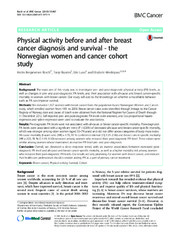| dc.contributor.author | Borch, Kristin Benjaminsen | |
| dc.contributor.author | Braaten, Tonje | |
| dc.contributor.author | Lund, Eiliv | |
| dc.contributor.author | Weiderpass, Elisabete | |
| dc.date.accessioned | 2016-03-08T12:29:29Z | |
| dc.date.available | 2016-03-08T12:29:29Z | |
| dc.date.issued | 2015-12-16 | |
| dc.description.abstract | Background: The main aim of this study was to investigate pre- and post-diagnostic physical activity (PA) levels, as well as changes in pre- and post-diagnostic PA levels, and their association with all-cause and breast cancer-specific mortality in women with breast cancer. Our study will add to the knowledge on whether a modifiable behavior such as PA can improve survival.
<p>Methods: We included 1,327 women with breast cancer from the population-based Norwegian Women and Cancer study, which enrolled women from 1991 to 2003. Breast cancer cases were identified through linkage to the Cancer Registry of Norway; date and cause of death were obtained from the National Register for Causes of Death through 31 December 2012. Self-reported pre- and post-diagnostic PA levels were assessed, and Cox proportional hazard regression and spline regression were used to evaluate the associations.
<p>Results: Pre-diagnostic PA levels were not associated with all-cause or breast cancer-specific mortality. Post-diagnostic PA levels were associated with a significant trend (P < 0.001) of decreased all-cause and breast cancer-specific mortality, which was stronger among older women (aged 50–74 years) and did not differ across categories of body mass index. All-cause mortality (hazard ratio [HR] = 1.76, 95 % confidence interval [CI] 1.21–2.56) and breast cancer-specific mortality (HR = 2.05, 95 % CI 1.35–3.10) increased among women who reduced their post-diagnostic PA level. These values were similar among women whose maintained an inactive PA level pre- and post-diagnosis.
<p>Conclusion: Overall, we observed a dose–response trend, with an inverse association between increased postdiagnostic PA level and all-cause and breast cancer-specific mortality, as well as a higher mortality risk among women who reduced their post-diagnostic PA levels. Our results are very promising for women with breast cancer, and indicate that health care professionals should consider adding PA as a part of primary cancer treatment. | en_US |
| dc.description | Published version, also at <a href=http://dx.doi.org/10.1186/s12885-015-1971-9>
http://dx.doi.org/10.1186/s12885-015-1971-9</a> | en_US |
| dc.identifier.citation | BMC Cancer (2015) 15:967 | en_US |
| dc.identifier.cristinID | FRIDAID 1307115 | |
| dc.identifier.doi | 10.1186/s12885-015-1971-9 | |
| dc.identifier.issn | 1471-2407 | |
| dc.identifier.uri | https://hdl.handle.net/10037/8754 | |
| dc.identifier.urn | URN:NBN:no-uit_munin_8332 | |
| dc.language.iso | eng | en_US |
| dc.publisher | BioMed Central | en_US |
| dc.rights.accessRights | openAccess | |
| dc.subject | VDP::Medisinske Fag: 700::Helsefag: 800::Forebyggende medisin: 804 | en_US |
| dc.subject | VDP::Medical disciplines: 700::Health sciences: 800::Preventive medicine: 804 | en_US |
| dc.subject | Breast cancer | en_US |
| dc.subject | Physical activity | en_US |
| dc.subject | Survival | en_US |
| dc.subject | Cohort | en_US |
| dc.title | Physical activity before and after breast cancer diagnosis and survival - the Norwegian women and cancer cohort study | en_US |
| dc.type | Journal article | en_US |
| dc.type | Tidsskriftartikkel | en_US |
| dc.type | Peer reviewed | en_US |


 English
English norsk
norsk